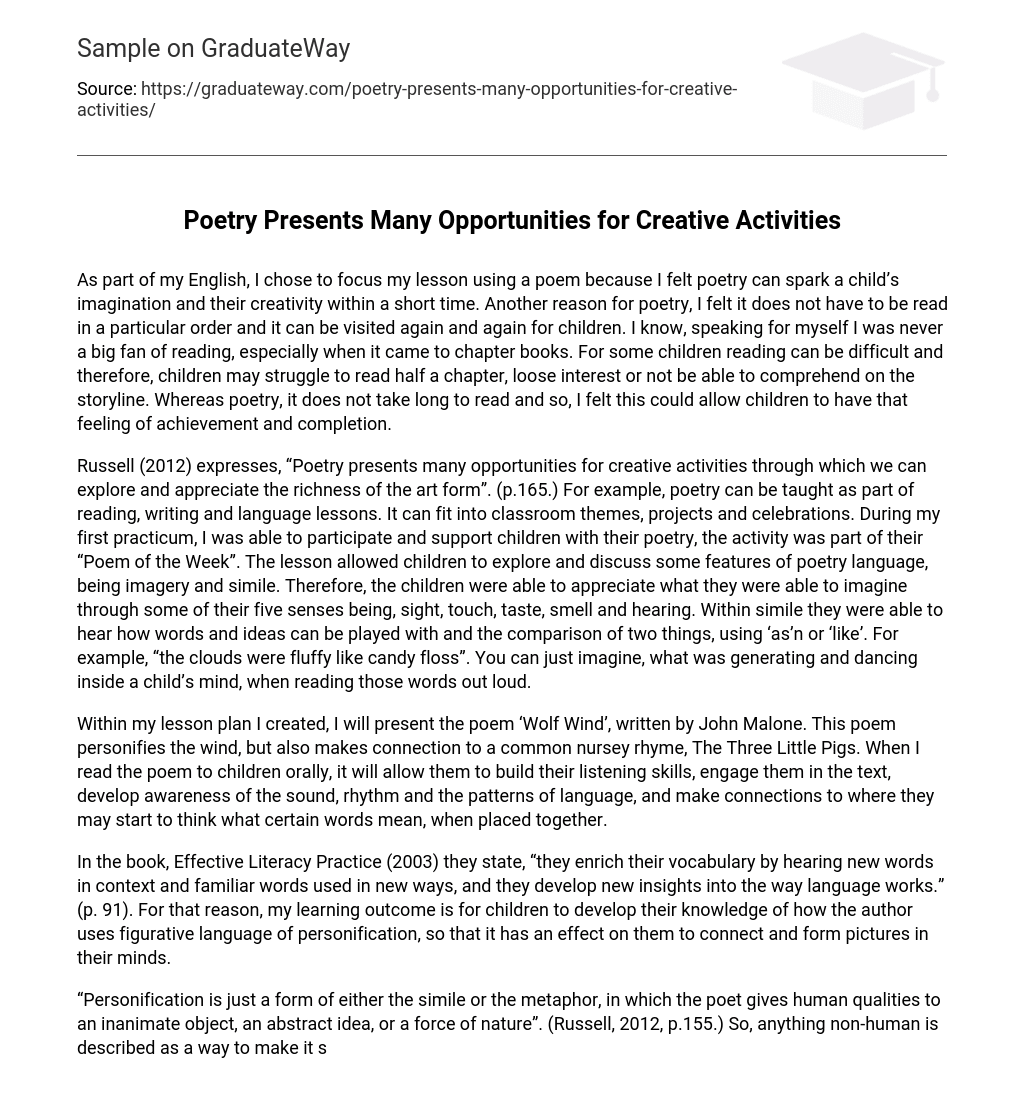As part of my English, I chose to focus my lesson using a poem because I felt poetry can spark a child’s imagination and their creativity within a short time. Another reason for poetry, I felt it does not have to be read in a particular order and it can be visited again and again for children. I know, speaking for myself I was never a big fan of reading, especially when it came to chapter books. For some children reading can be difficult and therefore, children may struggle to read half a chapter, loose interest or not be able to comprehend on the storyline. Whereas poetry, it does not take long to read and so, I felt this could allow children to have that feeling of achievement and completion.
Russell (2012) expresses, “Poetry presents many opportunities for creative activities through which we can explore and appreciate the richness of the art form”. (p.165.) For example, poetry can be taught as part of reading, writing and language lessons. It can fit into classroom themes, projects and celebrations. During my first practicum, I was able to participate and support children with their poetry, the activity was part of their “Poem of the Week”. The lesson allowed children to explore and discuss some features of poetry language, being imagery and simile. Therefore, the children were able to appreciate what they were able to imagine through some of their five senses being, sight, touch, taste, smell and hearing. Within simile they were able to hear how words and ideas can be played with and the comparison of two things, using ‘as’n or ‘like’. For example, “the clouds were fluffy like candy floss”. You can just imagine, what was generating and dancing inside a child’s mind, when reading those words out loud.
Within my lesson plan I created, I will present the poem ‘Wolf Wind’, written by John Malone. This poem personifies the wind, but also makes connection to a common nursey rhyme, The Three Little Pigs. When I read the poem to children orally, it will allow them to build their listening skills, engage them in the text, develop awareness of the sound, rhythm and the patterns of language, and make connections to where they may start to think what certain words mean, when placed together.
In the book, Effective Literacy Practice (2003) they state, “they enrich their vocabulary by hearing new words in context and familiar words used in new ways, and they develop new insights into the way language works.” (p. 91). For that reason, my learning outcome is for children to develop their knowledge of how the author uses figurative language of personification, so that it has an effect on them to connect and form pictures in their minds.
“Personification is just a form of either the simile or the metaphor, in which the poet gives human qualities to an inanimate object, an abstract idea, or a force of nature”. (Russell, 2012, p.155.) So, anything non-human is described as a way to make it seem human. For example, in the text “Wolf Wind” the author has the wind talking like a person or giving it an emotion, “Let me in! Let me in! cries the wolf wind over and over”, clearly the wind does not talk, but when using personification, objects like the wind do things human can and as mentioned before, it helps us to create these images in our minds.
As part of my lesson plan, when giving an example and teaching the word personification to the children, I will utilise their classroom for ideas to create personification. For instance, I will ask the children to look and list non-living nouns they see in their classroom, such as clock, book, chair and so on, and a list of verbs that describes a person’s action, such as screamed, danced, run and so on.
Followed by this, I will show children how combining a noun with a verb can form personification. A simple example could be, clock-screamed, chair-moaned. To broaden on their literature from that, I would get the children to produce some writing, such as; the old chair moaned, as the boy jumped on it. The printer ate all the paper up. My lesson will be kept simple, and focused on one area. Saxby, (1997) states, “poetry is to provide children with an appreciation of a form that will stay with them for life” (p.167)
Therefore. I am not yet a teacher, nor am I a poet but within my simple lesson plan, I can begin to engage children in words that they not only just see or imagine in a heightened way, but to interpret what they see creatively and in a fun learning environment that they will concept the full understanding of the figurative language; personification.





